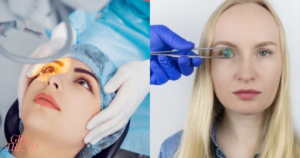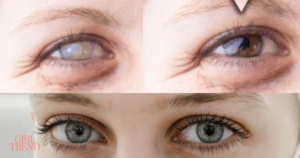Introduction:
If you regularly wear contact lenses and are considering laser eye surgery and lens replacement surgery, this article is intended to offer you useful information. When you schedule your first appointment for an assessment, you will be asked to stop wearing contact lenses before your consultation.
Contact lenses can change the shape of your cornea, and it may take a few weeks for your corneas to return to their natural shape. Your eye doctor needs to see the true shape of your cornea to give you the best vision solution.
While you will be told exactly how long to avoid wearing contacts when you book your appointment, here is a general guide:
- Soft contacts: Stop wearing these one to two weeks before your first consultation.
- Toric soft lenses or RGP lenses: Stop wearing these at least three weeks before your initial evaluation.
- Hard lenses: Stop wearing these at least four weeks before your initial evaluation.
These are just general guidelines, and some clinics or doctors might suggest slightly different timings.
If you only wear contact lenses and don’t have glasses, one of our refractive consultants will need to give you more advice before your evaluation.
If you depend on glasses or contact lenses to see clearly, you’ve likely thought about whether laser eye surgery could help you stop needing them. Maybe you’ve heard some people share success stories, but you might also know others who still need glasses even after having the surgery.
Eye lens replacement includes two types of surgery: cataract surgery and refractive lens exchange. Both surgeries involve removing your eye’s natural lens and replacing it with an intraocular lens (IOL). Your provider will help you choose the best IOL for you. The procedure is usually quick, taking about 30 minutes or less, and you can typically return to your normal activities soon afterward.
Before laser eye surgery:
If you decide to go ahead with laser eye surgery, your corneas need to be in their natural shape when the procedure takes place. This could take up to four weeks, depending on the type of contact lenses you usually wear. You will receive specific instructions when you book your laser eye surgery.
Contact-lens-related problems:

A common reason for thinking about laser eye surgery is when, after wearing contact lenses for many years, you start noticing that your eyes feel dry during the day, or you experience more discomfort. Some people also find that wearing contact lenses for a long time can lead to corneal abrasions, infections, or corneal ulcers.
Often, changing the type of contact lens (as your optometrist recommends) can solve the problem. However, if the issue continues, you may need to consider wearing glasses or opting for a vision correction procedure like laser eye surgery.
Most people can get rid of their glasses after having laser eye surgery:
For most people, laser eye surgery improves their distance vision to be as good as or better than it is with glasses. After the procedure, most patients can read as well as they can with their best glasses or contacts.
However, whether you’ll be completely free from glasses or contacts after the surgery depends on a few important factors:
– Your prescription strength and the type of vision problem (e.g., short-sightedness, long-sightedness, or astigmatism)
– Your surgeon’s experience and the technology used
– Your age
What is eye lens replacement?

Eye lens replacement is an outpatient surgery where an eye doctor (ophthalmologist) removes your eye’s natural lens and replaces it with an intraocular lens (IOL) to improve your vision. Your natural lens is a clear part of the eye located behind your pupil that helps focus light onto your retina, allowing you to see clearly. An IOL is a clear artificial lens, usually made of acrylic or silicone, that performs the same function.
Eye lens replacement surgery refers to two specific types of procedures:
– Cataract surgery
– Refractive lens exchange
1. Cataract surgery
Cataract surgery involves removing a cloudy lens and replacing it with a clear one. Cataracts are cloudy patches that develop in your eye’s lens as you age, usually starting after age 40, with symptoms like blurry vision becoming noticeable after age 60. If cataracts interfere with your daily life, your doctor may recommend surgery to implant an IOL and restore your vision.
Why get this surgery?
Cataracts can develop as you age when the fibers in the lens of your eye become stiffer, causing your vision to become cloudy. They can also be a congenital issue, passed down through families. Congenital cataracts are a leading cause of childhood blindness, and surgery is often performed within the first six weeks of life.
Whether lens replacement surgery is the right choice for you should be decided in consultation with a surgeon. Surgery is typically recommended when vision problems start to affect your ability to safely perform daily activities, such as driving or reading.
2. Refractive lens exchange
Refractive lens exchange is a corrective eye surgery that replaces your clear lens with an IOL. Unlike cataract surgery, where the natural lens is cloudy, in refractive lens exchange, the natural lens is clear. This procedure, also known as “clear lens extraction,” is done to correct refractive errors, such as nearsightedness or farsightedness, so you may need glasses or contacts less often. Refractive lens exchange is an option for people who are not suitable candidates for LASIK or PRK, which are other vision correction surgeries that reshape the cornea, the outer part of the eye.
What are the different types of eye lens replacement?
There are various types of intraocular lenses (IOLs) available to replace your eye’s natural lens, each with its benefits and drawbacks. The three general categories of IOLs are:
- Monofocal lenses:
Monofocal lenses correct your vision at one specific range, usually for distance vision. You may still need glasses for reading or other close-up tasks.
- Multifocal lenses:
Multifocal lenses correct your vision at two or more ranges, helping you see clearly at both distance and near without relying on glasses.
- Toric lenses:
Toric lenses are designed to correct astigmatism, a condition where the cornea or lens has an irregular shape, causing blurred vision.
Benefits of Lens Replacement Surgery:
Lens replacement surgery offers several benefits:
– Improved Vision: The surgery can correct both distance and near vision, stabilize your vision over time, and prevent cataracts from affecting your eyesight as you age. This means that your vision remains clear and stable for years after the procedure.
– Reduced Dependence on Glasses: Many patients find they rarely, if ever, need glasses after the surgery. This makes the surgery especially beneficial for those who have never worn glasses before but are now becoming more dependent on them for seeing both at a distance and up close.
According to Dr. Brusco, these benefits give patients the most visual freedom among the available procedures. Dr. Kim also highlights that this surgery is ideal for those who want to minimize their reliance on glasses.
How does Lens replacement surgery work?
“Lens replacement surgery is a very quick, safe, and comfortable procedure for the patient,” says Dr. Kim. “Most patients are driving within 72 hours after the surgery,” adds Illinois-based ophthalmologist Dr. Benjamin Ticho.
The surgery begins with sedating the patient, who remains awake throughout the procedure. This sedation helps with anxiety and any minor pain. While the patient lies on their back, the eye surgeon makes a small incision where the cornea meets the sclera (the white part of the eye).
Next, the surgeon uses a phacoemulsification ultrasound probe to remove the natural lens from the front-facing, internal part of the eye. This process leaves behind a clean sac that normally holds the human lens. The surgeon then implants a synthetic intraocular lens (IOL) of choice into this sac. The entire procedure typically takes between five and 15 minutes per eye. The surgery is completed when the surgeon confirms that the eye pressure is at a good level and the incisions are watertight.
Outcomes for lens replacement surgery:
About 95% of patients no longer need glasses or contact lenses after lens replacement surgery. Only around 5% of patients may still need to use glasses or contact lenses occasionally for certain activities.
The future of lens replacement surgery:
Research is ongoing to improve lens replacement surgery and the artificial lenses used. Recently, a new type of lens called light-adjustable lenses has been developed. These lenses are made of light-sensitive silicone and allow your surgeon to adjust the lens power after the surgery to better match your needs. This innovation aims to increase the number of patients who can achieve complete freedom from glasses and contact lenses.

Are there risks to lens replacement surgery?
As with any surgery, lens replacement surgery carries some risks.
The most significant risk is retinal detachment, which can damage your vision. This occurs in about 1.5% to 8% of lens replacement surgeries and is more common in people undergoing surgery to correct myopia (nearsightedness).
Other potential risks include:
– Pain
– Swelling
– Bruising
– Bleeding
– Uveitis (inflammation of the eye’s middle layer)
– Posterior capsular opacification, which occurs in about 30% of cases after surgery, according to a 2009 study
– Endophthalmitis (an eye infection)
– Temporary increase in eye pressure (glaucoma)
Whether you have traditional or laser lens replacement surgery, the risks and recovery time are generally similar. Full recovery usually takes about one month.
Conclusion:
Lens replacement surgery is highly effective for most patients, with about 90% achieving freedom from glasses after receiving a multifocal lens. The stability of the artificial lens, combined with ongoing advancements such as light-adjustable lenses, offers a promising solution for maintaining clear vision. As long as the eye remains healthy, the benefits of the surgery are long-lasting and significant.



